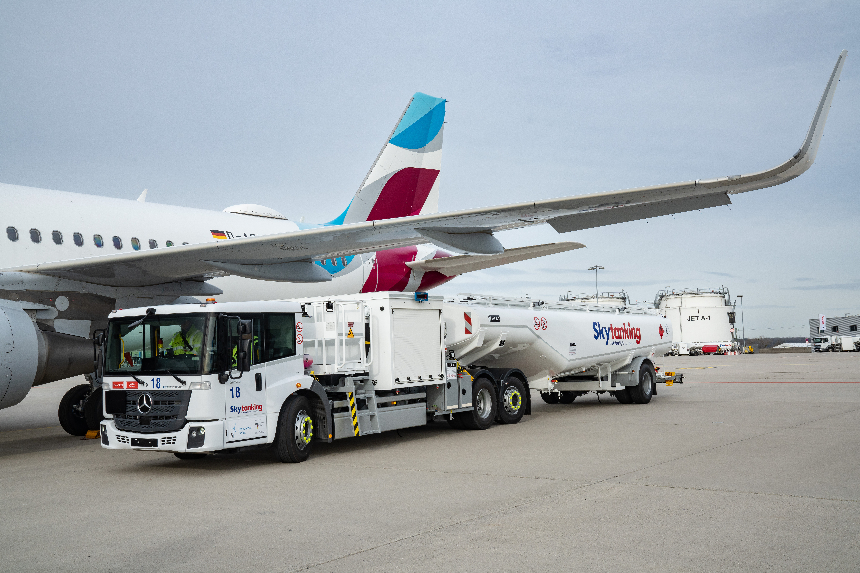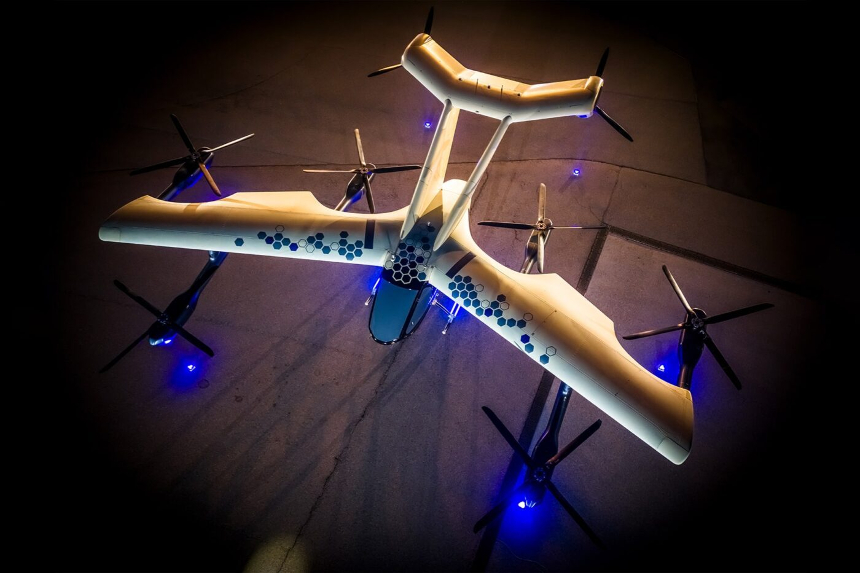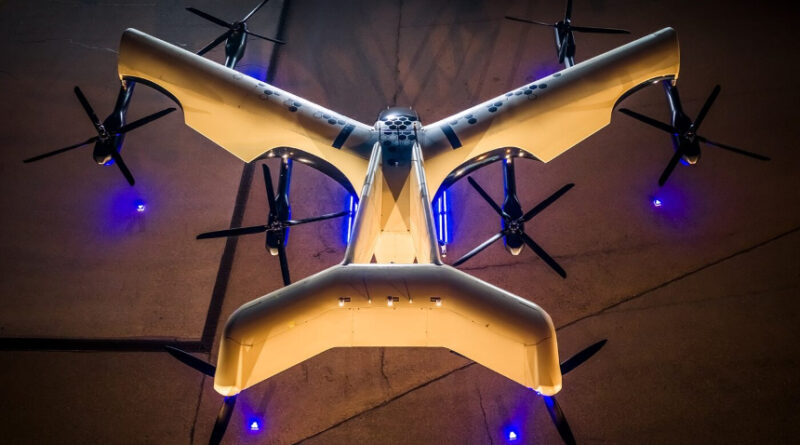Electricity & Airplanes — Lowering The Carbon Emissions Of Flight
There are two news stories out today that focus on different ways of using electricity to reduce the carbon emissions of airplanes. The first comes from Mercedes-Benz, which has worked with several partners to create a refueling vehicle for airplanes that is battery-powered.
We don’t often pay much attention to the all the vehicles that service airplanes when they are on the ground, the ones that bring the jet fuel, transport luggage back and forth to the terminal, shuttle passengers from one part of an airport to another, plow runways, shuttle maintenance people around, and so forth. But look out the window next time you are at an airport or onboard an aircraft and notice all the vehicles scurrying about. Almost all of them are powered by a gasoline or diesel engine, which means they are leaving an invisible cloud of exhaust gases in their wake.
Mercedes Electrifies Refueling For Airplanes

Working with tank body specialist Esterer, Mercedes-Benz has modified an eEconic battery-electric truck so it can bring a 40,000 liter (10,500 gallon) tank filled with jet fuel to airplanes waiting to refuel on the runway. The energy for the refueling pump comes directly from the truck’s batteries, Mercedes explains in a press release.
“The development of a high performance commercial vehicle with a total weight of over 50 tons was a special challenge for us,” said Julia Esterer, managing director of Esterer. “The selection of the right components was decisive in order to achieve optimum performance at the interface to the high voltage technology. Today, we can present a comprehensive solution that is forward looking, both economically and environmentally.”
The Mercedes-Benz eEconic is a low floor truck that is less than 2.8 meters (9 feet) high, which allows it to fit underneath the wings of most commercial airplanes. It is fitted with two electric motors, generating up to 330 kW of continuous power. The truck can be recharged with up to 160 kW. The battery-electric drive system reduces noise and heat generation and emits neither carbon dioxide nor particulate matter, which benefits the employees in the direct vicinity the truck during refueling operations.
In order to fulfill its mission at Stuttgart Airport, the eEconic needs to be charged for about one hour a day, which provides enough energy “for the vehicle and tank body to be used for ground handling operations without charging interruptions.” The eConic electric truck will be part of Stuttgart Airport’s climate STRzero program that is intended to reduce its direct greenhouse gas emissions to net zero by 2040.
“We are delighted that our locally CO2-neutral eEconic is in demand for an increasing number of applications and is now being used with a tank body for the first time,” Franziska Cusumano, Head of Mercedes-Benz Special Trucks. “As an all electric truck, it will help reduce emissions in ground handling operations at Stuttgart Airport.”
Airbus eVTOL Airplanes To Debut This Year

And now for something completely different. After five years in development, Airbus has officially introduced its first battery-electric powered VTOL (vertical takeoff and landing) aircraft (which looks a lot like an overgrown moth in plan view). It is powered by eight electric motors driving propellers — six attached to the wings and two mounted to the tail. Those six propellers do the heavy lifting (literally) of getting the plane off the ground, and the two in the rear push it forward once aloft.
Fixed wings spanning twelve meters (40 feet) carry the eVTOL body, which has a V-shaped tail. Airbus has specified sound levels of less than 65 dB during fly-overs and below 70 dB during takeoff and landing. Other technical details remain unknown at this time.
The CityAirbus prototype is what is known as a two-ton aircraft, which we presume refers to its carrying capacity, not its total weight. The aircraft will be able to carry four passengers approximately 80 kilometers (50 miles) at speeds of up to 120 km/h (75 mph). Airbus says it considers the battery-electric aircraft “perfectly suited for operations in major cities for a variety of missions.”
The unveiling coincided with the opening of the new CityAirbus test center in Donauwörth, which will be dedicated to testing systems for electric vertical takeoff and landing vehicles. The center is part of the company’s long term investment in Advanced Air Mobility. The CityAirbus NextGen test center began operations in December, 2023 and it will be used for the remaining tests required before the maiden flight of the prototype later this year. These tests will evaluate the electric motors and the eight propellers as well as the aircraft’s other systems such as flight controls and avionics.
“Rolling out CityAirbus NextGen for the very first time is an important and very real step that we are taking towards advanced air mobility and our future product and market. Thank you to our community, team and partners all over the world for helping us make this a reality,” said Balkiz Sarihan, head of urban air Mobility at Airbus.
At the same time, Airbus is expanding its global network and partnerships to create a unique ecosystem that will foster a successful and viable AAM market. Airbus recently signed a partnership agreement with LCI, a leading aviation company, to focus on the development of partnership scenarios and business models in three core AAM areas — strategy, commercialization, and financing.
 Chip in a few dollars a month to help support independent cleantech coverage that helps to accelerate the cleantech revolution!
Chip in a few dollars a month to help support independent cleantech coverage that helps to accelerate the cleantech revolution!
The Takeaway
We tend to focus on electric cars (which means we may be ignoring the problem of having too many vehicles in the world, even if they are powered by pixie dust), but there are many other vehicles that contribute to greenhouse gas emissions — construction equipment, airplanes, mining trucks — that also exacerbate the curse of an overheating planet. All vehicles need to be electrified if we are to lower carbon dioxide levels significantly.
One electric tanker truck at the airport in Stuttgart will not have a measurable impact on the Earth’s environment, but it will send a message that electric vehicles are not the stuff of science fiction any more. Short-range electric airplanes like the CityAirbus can not only fly without emissions, they could also help reduce vehicle congestion. Imagine if city dwellers could avoid owning cars altogether because there were other methods of transportation available that are cheaper and more convenient!
Both of these announcements are a small part of a bigger picture. The electrification of transportation — all transportation — is happening, right now, today, in places all around the world. The EV revolution is moving forward, no matter what the nattering nabobs of negativism might say.
Have a tip for CleanTechnica? Want to advertise? Want to suggest a guest for our CleanTech Talk podcast? Contact us here.
Latest CleanTechnica.TV Video

CleanTechnica uses affiliate links. See our policy here.

